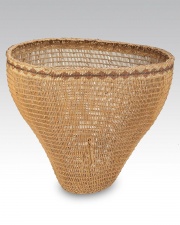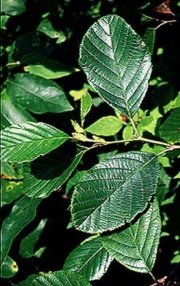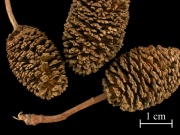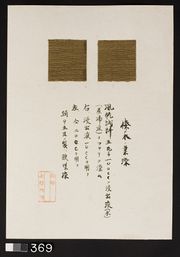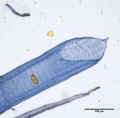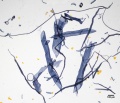Difference between revisions of "Alder"
(username removed) |
|||
| (22 intermediate revisions by 4 users not shown) | |||
| Line 1: | Line 1: | ||
| − | [[File:1992.150-SC58812.jpg|thumb| | + | [[File:1992.150-SC58812.jpg|thumb|Gathering basket<br>MFA# 1992.150]] |
== Description == | == Description == | ||
| − | Several species of deciduous trees from the genus ''Alnus''. Alders are in the same family as birch trees. The wood from alder trees has a smooth, fine, straight grain; it is tough and resilient. The red alder, ''A. rubra'' or ''A. oregana'', found along the west coast of the US and Canada, has reddish-brown wood that is prized for cabinetry, furniture, and imitation mahogany. Wood from other alder trees is used for plywood, shoe heels, bobbins, cogs, and other small turned items. The bark from the black alder, ''A. glutinosa'', was used in 15th century Europe to produce a black dye for cloth. Native Americans and Eskimos also used red alder bark to make a brown dye for basket materials and reindeer skins. Alder bark and fruit contains up to 16% tannins and they have occasionally been used for tanning leather. However, alder produces a brittle leather unless used in conjunction with other tannins. | + | Several species of deciduous trees from the genus ''Alnus''. Alders are in the same family as birch trees. The wood from alder trees has a smooth, fine, straight grain; it is tough and resilient. The red alder, ''A. rubra'' or ''A. oregana'', found along the west coast of the US and Canada, has reddish-brown wood that is prized for cabinetry, furniture, and imitation mahogany. Wood from other alder trees is used for plywood, shoe heels, bobbins, cogs, and other small turned items. The bark from the black alder, ''A. glutinosa'', was used in 15th century Europe to produce a black dye for cloth. Native Americans and Eskimos also used red alder bark to make a brown dye for basket materials and reindeer skins. Alder bark and fruit contains up to 16% tannins and they have occasionally been used for tanning leather. However, alder produces a brittle leather unless used in conjunction with other tannins. The bark from a red alder produces a russet color dye, while dried leaves from ''Alnus japonica'' produce ochers color dyes. |
[[File:image 5-Alder.jpg|thumb|Alder tree]] | [[File:image 5-Alder.jpg|thumb|Alder tree]] | ||
| + | See also [[https://cameo.mfa.org/wiki/Category:Uemura_dye_archive '''Uemera Dye Archive''' (Alder and Hari)]] | ||
| + | [[File:Alder_cones_yasha.jpg|thumb|Alder(''Alnus firma'')]] | ||
| + | [[File:Uemura 10-08-2009 369.jpg|thumb|Two silk samples dyed with alder leaves<br>Uemera Dye Archive]] | ||
== Synonyms and Related Terms == | == Synonyms and Related Terms == | ||
| − | red alder (''Alnus rubra''); Oregon alder (''Alnus oregana''); black alder (''Alnus glutinosa''); yasha (Jap.); el- | + | red alder (''Alnus rubra''); Oregon alder (''Alnus oregana''); black alder (''Alnus glutinosa''); yasha (Jap.); el-slægten (Dan.); Erlen (Deut.); aliso (Esp.); aulne (Fr.); ontano (It.); els (Ned.); olsza, olcha (Pol.): amieiro (Port.) |
| − | == | + | == Physical and Chemical Properties == |
| − | Tree height = 30-35 m Bark = smooth, light gray, often covered with white lichens Flowers = catkins, male and female on same tree (late spring) Fruit = semi-woody cone | + | * Tree height = 30-35 m Bark = smooth, light gray, often covered with white lichens |
| + | * Flowers = catkins, male and female on same tree (late spring) Fruit = semi-woody cone | ||
| + | * Specific gravity = 0.53 | ||
| + | * Density = 28-33 ppcf | ||
| − | + | Paper fiber type: hardwood, diffuse porous. Using transmitted light microscopy, pulp is identified by long vessels (up to 1mm) with a tapered point and alternate, small pitting. Perforations are scalariform with 12-25 bars, some branched. Vascular trachieds may be present. Appearance with [[Graff "C" stain]]: dark blue, but varies with bleaching. Average dimensions of fibers: length, 1.2mm. 28μm wide. Common pulping method: [[kraft process|kraft]]. | |
| − | |||
| − | |||
| − | |||
| − | |||
| − | |||
| − | |||
| − | |||
| − | |||
| − | |||
| − | ( | ||
| − | |||
| − | |||
| − | |||
== Additional Images == | == Additional Images == | ||
| Line 34: | Line 27: | ||
File:1_Red Alder_100x_Tan.jpg|Red alder (''Alnus rubrum'') | File:1_Red Alder_100x_Tan.jpg|Red alder (''Alnus rubrum'') | ||
File:1_Red Alder_100x_Tran.jpg|Red alder (''Alnus rubrum'') | File:1_Red Alder_100x_Tran.jpg|Red alder (''Alnus rubrum'') | ||
| + | File:Alder 40x2.jpg|Black alder paper pulp | ||
| + | File:Alder 10x.jpg|Black alder paper pulp | ||
</gallery> | </gallery> | ||
| − | + | == Resources and Citations == | |
| − | == | + | * Schoch, W., Heller, I., Schweingruber, F.H., Kienast, F., 2004: [http://www.woodanatomy.ch/ Wood anatomy of central European Species]: Black Alder, [http://www.woodanatomy.ch/species.php?code=ALGL Alnus glutinosa Gaertn.] |
| − | + | * Matt Roberts, Don Etherington, ''Bookbinding and the Conservation of Books: a Dictionary of Descriptive Terminology'', U.S. Government Printing Office, Washington DC, 1982 | |
| − | * | + | * G.S.Brady, ''Materials Handbook'', McGraw-Hill Book Co., New York, 1971 |
| − | |||
| − | * | ||
| − | |||
* ''Dictionary of Building Preservation'', Ward Bucher, ed., John Wiley & Sons, Inc., New York City, 1996 | * ''Dictionary of Building Preservation'', Ward Bucher, ed., John Wiley & Sons, Inc., New York City, 1996 | ||
| − | + | * Palmy Weigle, ''Ancient Dyes for Modern Weavers'', Watson-Guptill Publications, New York, 1974 | |
| − | * | + | * F. H. Titmuss, ''Commercial Timbers of the World'', The Technical Press Ltd., London, 1965 |
| − | + | * Virginia Tech Dendrology website at www.fw.vt.edu/dendro/dendrology/main.htm (accessed Oct. 3, 2005) | |
| − | * | + | * Wikipedia: [https://en.wikipedia.org/wiki/Alder Alder] (Accessed Oct. 3, 2005 and October 2024) |
| − | |||
| − | * | ||
| − | |||
| − | * Wikipedia | ||
| − | |||
* ''CRC Handbook of Chemistry and Physics'', Robert Weast (ed.), CRC Press, Boca Raton, Florida, v. 61, 1980 Comment: density=26-42 ppcf (0.42-0.68 g/cm3) | * ''CRC Handbook of Chemistry and Physics'', Robert Weast (ed.), CRC Press, Boca Raton, Florida, v. 61, 1980 Comment: density=26-42 ppcf (0.42-0.68 g/cm3) | ||
| − | + | * Marja-Sisko Ilvessalo-Pfäffli. ''Fiber Atlas: Identification of Papermaking Fibers'' (Springer Series in Wood Science). Springer, 1995. | |
| − | + | * Walter Rantanen. "Fiber ID Course." Integrated Paper Services. June 2013. Lecture. | |
[[Category:Materials database]] | [[Category:Materials database]] | ||
Latest revision as of 14:13, 17 November 2024
Description
Several species of deciduous trees from the genus Alnus. Alders are in the same family as birch trees. The wood from alder trees has a smooth, fine, straight grain; it is tough and resilient. The red alder, A. rubra or A. oregana, found along the west coast of the US and Canada, has reddish-brown wood that is prized for cabinetry, furniture, and imitation mahogany. Wood from other alder trees is used for plywood, shoe heels, bobbins, cogs, and other small turned items. The bark from the black alder, A. glutinosa, was used in 15th century Europe to produce a black dye for cloth. Native Americans and Eskimos also used red alder bark to make a brown dye for basket materials and reindeer skins. Alder bark and fruit contains up to 16% tannins and they have occasionally been used for tanning leather. However, alder produces a brittle leather unless used in conjunction with other tannins. The bark from a red alder produces a russet color dye, while dried leaves from Alnus japonica produce ochers color dyes.
See also [Uemera Dye Archive (Alder and Hari)]
Synonyms and Related Terms
red alder (Alnus rubra); Oregon alder (Alnus oregana); black alder (Alnus glutinosa); yasha (Jap.); el-slægten (Dan.); Erlen (Deut.); aliso (Esp.); aulne (Fr.); ontano (It.); els (Ned.); olsza, olcha (Pol.): amieiro (Port.)
Physical and Chemical Properties
- Tree height = 30-35 m Bark = smooth, light gray, often covered with white lichens
- Flowers = catkins, male and female on same tree (late spring) Fruit = semi-woody cone
- Specific gravity = 0.53
- Density = 28-33 ppcf
Paper fiber type: hardwood, diffuse porous. Using transmitted light microscopy, pulp is identified by long vessels (up to 1mm) with a tapered point and alternate, small pitting. Perforations are scalariform with 12-25 bars, some branched. Vascular trachieds may be present. Appearance with Graff "C" stain: dark blue, but varies with bleaching. Average dimensions of fibers: length, 1.2mm. 28μm wide. Common pulping method: kraft.
Additional Images
Resources and Citations
- Schoch, W., Heller, I., Schweingruber, F.H., Kienast, F., 2004: Wood anatomy of central European Species: Black Alder, Alnus glutinosa Gaertn.
- Matt Roberts, Don Etherington, Bookbinding and the Conservation of Books: a Dictionary of Descriptive Terminology, U.S. Government Printing Office, Washington DC, 1982
- G.S.Brady, Materials Handbook, McGraw-Hill Book Co., New York, 1971
- Dictionary of Building Preservation, Ward Bucher, ed., John Wiley & Sons, Inc., New York City, 1996
- Palmy Weigle, Ancient Dyes for Modern Weavers, Watson-Guptill Publications, New York, 1974
- F. H. Titmuss, Commercial Timbers of the World, The Technical Press Ltd., London, 1965
- Virginia Tech Dendrology website at www.fw.vt.edu/dendro/dendrology/main.htm (accessed Oct. 3, 2005)
- Wikipedia: Alder (Accessed Oct. 3, 2005 and October 2024)
- CRC Handbook of Chemistry and Physics, Robert Weast (ed.), CRC Press, Boca Raton, Florida, v. 61, 1980 Comment: density=26-42 ppcf (0.42-0.68 g/cm3)
- Marja-Sisko Ilvessalo-Pfäffli. Fiber Atlas: Identification of Papermaking Fibers (Springer Series in Wood Science). Springer, 1995.
- Walter Rantanen. "Fiber ID Course." Integrated Paper Services. June 2013. Lecture.
